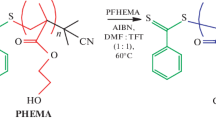Abstract
The apparent contact angles of dodecane droplets deposited on a 50:50 nylon:cotton blended woven fabric (NyCo) were measured, and the characteristics required for an ultraoleophobic surface were described. The metastable Cassie–Baxter model, a transition status from the original Cassie–Baxter model to the Wenzel model, was investigated to design ultraoleophobic surfaces and to understand the wetting behavior of such surfaces. Using chemical and geometrical modifications of NyCo, a surface having contact angles to dodecane of greater than 150° and water contact angles of greater than 165° has been prepared. Good agreement between the predicted and measured contact angles was obtained. Developing a superhydrophobic ultraoleophobic material has been achieved by two criteria: a low-surface-energy and a properly designed surface morphology.







Similar content being viewed by others
References
Cai Y, Li Q, Wei Q, Wu Y, Song L, Hu Y (2008) J Mater Sci 43:6132. doi:10.1007/s10853-008-2921-6
Lee B, Dai G (2009) J Mater Sci 44:4848. doi:10.1007/s10853-009-3739-6
Pascual M, Balart R, Sanchez L, Fenollar O, Calvo O (2008) J Mater Sci 43:4901. doi:10.1007/s10853-008-2712-0
Berketis K, Tzetzis D (2009) J Mater Sci 44:3578. doi:10.1007/s10853-009-3485-9s
Huang X, Fang X, Lu Z, Chen S (2009) J Mater Sci 44:4522. doi:10.1007/s10853-009-3660-z
Lee HJ (2009) J Mater Sci 44:4645. doi:10.1007/s10853-009-3711-5
Mueller-Plathe F, Pal S, Weiss H, Keller H (2005) Soft Mater 3:21
Hoefnagels HF, Wu D, de With G, Ming W (2007) Langmuir 23:13158
Brewer SA, Willis CR (2008) Appl Surf Sci 254:6450
Ahuja A, Taylor JA, Lifton V, Sidorenko AA, Salamon TR, Lobaton EJ, Kolodner P, Krupenkin TN (2008) Langmuir 24:9
Lee HJ, Willis C (2009) Chem Ind 21
Tuteja A, Choi W, Ma M, Mabry JM, Mazzella SA, Rutledge GC, McKinley GH, Cohen RE (2007) Science 318:1618
Lee HJ, Michielsen S (2007) J Polym Sci B 45:253
Tuteja A, Choi W, Mabry JM, McKinley GH, Cohen RE (2008) Proc Natl Acad Sci 105:18200
Leng B, Shao Z, de With G, Ming W (2009) Langmuir 25:2456
Steele A, Bayer I, Loth E (2009) Nano Lett 9:501
Lee HJ, Michielsen S (2006) J Text Inst 97:455
Cassie ABD, Baxter S (1944) Trans Faraday Soc 40:546
Wenzel RN (1936) Ind Eng Chem 28:988
Michielsen S, Lee HJ (2007) Langmuir 23:6004
Acknowledgement
This material is based on research sponsored by Air Force Research Laboratory under agreement number FA8650-07-1-5903. The U.S. Government is authorized to reproduce and distribute reprints for Governmental purposes notwithstanding any copyright notation thereon. The views and conclusions contained herein are those of the authors and should not be interpreted as necessarily representing the official policies or endorsements, either expressed or implied, of Air Force Research Laboratory or the U. S. Government. We appreciate support by US Army Natick Soldier Research Development and Engineering Center (NSRDEC) and Defense Threat Reduction Agency (DTRA).
Author information
Authors and Affiliations
Corresponding author
Rights and permissions
About this article
Cite this article
Lee, H.J., Owens, J.R. Design of superhydrophobic ultraoleophobic NyCo. J Mater Sci 45, 3247–3253 (2010). https://doi.org/10.1007/s10853-010-4332-8
Received:
Accepted:
Published:
Issue Date:
DOI: https://doi.org/10.1007/s10853-010-4332-8




